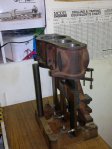Well as I sit here in my new (Christmas present) noise cancelling headphones that are doing a fine job of isolating me from the culinary marathon taking place in the kitchen, it seems a good time to provide an update on Winter ’23/’24 boat work list!
We have an extensive set of work, aiming to both address some mechanical and wood-related failures and hopefully upgrade Befur’s performance for 2024.
You might remember from the “year end review” we had a provisional list of work to do, and some of it we have done!!!! So below you will see the worklist together with notes on progress and on other jobs that made their way into the list.
-
Cleaning the inside of the boiler, removing oil to improve efficiency (reduce fuel consumption), and prevent overheating resulting from the insulation effects of oil-in-tubes.
-
Cleaning the inside of the condenser, for same reasons and to improve vacuum.
Well both of these activities have been concluded, as well as the first part of the annual boiler (a hydraulic test at 375psi). It was nice to see how little soot had accumulated in the years’ steaming – another advantage of liquid fueling.
The boiler was good and tight, holding it’s pressure for many minutes without pumping.
We had concluded that a less-than-perfect hotwell design had allowed some oil to make it into the boiler, so it seemed a good time to try to do a good job of cleaning it. The advice was to fill it with a mixture of detergent and TSP (trisodium phosphate), and then heat and circulate. The instructions for power station boilers suggest 48hrs will do, but I opted for a lot less!
We decided to do the condenser at the same time, and use the boiler to heat itself.
The video shows the process half way through. We left the boiler full to cool naturally, and then pumped the fluide round again, and this time we did collect some oil on the oil collecting cloths in the hot well. We then drained it down and repeated the process. Bringing the boiler to a boil and holding that temperature for an hour or two.
At the end I felt we had made some progress, and the oily “scum” in the sight glass was gone, and a considerable amount of oil was removed from the condenser – I think the latter is going to be a recurring problem as it resides between the engine and hotwell, ….
We also took the time to weigh the boiler (174Kg without the wooden cladding, and dry) – thus demonstrating another positive attribute of water-tube boilers, as a VFT102 Vertical Fire Tube boiler with half the heating surface of the John King Yarrow (17sq ft v 32 sq ft) weighs in at 300Kg!!!.
At this point I should add a promotional plug for SBA Services Limited (the trading arm of the SBA).
They offer a wide range of services (like boiler testing and boiler designs, and castings and engine designs) for steamboaters (both SBA members and others)), and publish the design of Boiler which I built for Befur (which did not need any welding, so is a home workshop proposition).
While we were doing this, I made a “spanner” to hold the headers of the Economiser or Superheater, which can tend to twist their respective tubes when attaching fittings etc.
We also tied some parts of the internal insulating board to the outer casing, which had slipped in service.
Lastly we made a new handpump. This is just a larger version of the one in Befur now, to reduce the number of strokes needed to fill or refill the boiler, this again was built using a casting from SBA Services. This is to a design by Ian Cross with drawings supplied with the casting prepared by John Maltby.
I decided to make this with an o-ring seal instead of a gland and stuffing box. An easy build, drilled to about 24 mm diameter, and then bored (with newly made boring tool) to 25mm. There are some pictures of this below. I forgot to video the final boring 😦
So, needing a post-xmas-lunch nap, I will hold over the rest of the rebuild story to the next post.
I will just mention that we (Paul Self and I) are planning to do some backyard foundry work to make a trumpet for Befur’s new siren. John Knapton (another of the Windermere mafia) has kindly 3D printed some fabulous casting patterns, which we will attempt to cast in bronze/brass in the next few weeks….(thank you John)….
<for next time>
- Remachining the LP crosshead and glands as it is now clear that this is the principal source of the hateful knocking the engine makes.
- Replacing the pump drive worm box, as this is at the point of failure, and adding “assistance springs” to reduce the torque requirements on this box, to extend its probable life! (probably another post here too).
- Replumbing the condenser to be “contraflow” as this should improve it’s efficiency too.
- Attempting to design and fit a clutch to the prop drive to allow it to freewheel when sailing.
- Attention to paint and varnish
- Possibly fitting a reinforcing inner fore-deck and removing the anchor chocks and resealing to improve weatherproofing.























